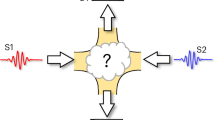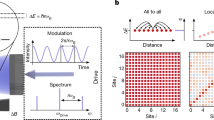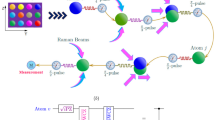Abstract
Fredkin’s Billiard Ball Model (BBM) is considered one of the fundamental models of collision-based computing, and it is essentially based on elastic collisions of mobile billiard balls. Moreover, fixed mirrors or reflectors are brought into the model to deflect balls to complete the computation. However, the use of fixed mirrors is “physically unrealistic” and makes the BBM not perfectly momentum conserving from a physical point of view, and it imposes an external architecture onto the computing substrate which is not consistent with the concept of “architectureless” in collision-based computing. In our initial attempt to reduce mirrors in the BBM, we present a class of gates: the m-counting gate, and show that certain circuits can be realized with few mirrors using this gate. We envisage that our findings can be useful in future research of collision-based computing in novel chemical and optical computing substrates.
Preview
Unable to display preview. Download preview PDF.
Similar content being viewed by others
References
Adamatzky, A.: Controllable transmission of information in the excitable media: the 2 + medium. Adv. Mater. Opt. Electron. 5, 145–155 (1995)
Adamatzky, A. (ed.): Collision-Based Computing. Springer, London (2002)
Adamatzky, A.: Collision-based computing in Belousov–Zhabotinsky medium. Chaos, Solitons & Fractals 21(5), 1259–1264 (2004)
Adamatzky, A., de Lacy Costello, B.: Binary collisions between wave-fragments in a sub-excitable Belousov–Zhabotinsky medium Chaos. Solitons & Fractals 34(2), 307–315 (2007)
Berlekamp, E.R., Conway, J.H., Guy, R.K.: Winning Ways for Your Mathematical Plays. Games in particular, vol. 2. Academic Press, London (1982)
Christodoulides, D.N., Lederer, F., Silberberg, Y.: Discretizing light behaviour in linear and nonlinear waveguide lattices. Nature 424, 817–823 (2003)
Dadda, L.: Some Schemes for Parallel Multipliers. Alta Frequenza 34, 349–356 (1965)
de Lacy Costello, B., Adamatzky, A.: Experimental implementation of collision-based gates in Belousov–Zhabotinsky medium Chaos. Solitons & Fractals 25(3), 535–544 (2005)
Fredkin, E., Toffoli, T.: Conservative logic. Int. J. Theor. Phys. 21(3-4), 219–253 (1982)
Margolus, N.: Physics-like models of computation. Physica D 10(1-2), 81–95 (1984)
Margolus, N.: Universal cellular automata based on the collisions of soft spheres. In: Adamatzky, A. (ed.) Collision-Based Computing, pp. 107–134. Springer, London (2002)
Sendiña-Nadal, I., Mihaliuk, E., Wang, J., Pérez-Muñuzuri, V., Showalter, K.: Wave Propagation in Subexcitable Media with Periodically Modulated Excitability. Phys. Rev. Lett. 86, 1646–1649 (2001)
Swartzlander Jr., E.E.: Parallel Counters. IEEE Trans. Comput. C–22 (11), 1021–1024 (1973)
Toth, R., Stone, C., Adamatzky, A., de Lacy Costello, B., Bull, L.: Experimental validation of binary collisions between wave fragments in the photosensitive Belousov–Zhabotinsky reaction Chaos. Solitons & Fractals (in press)
Wuensche, A., Adamatzky, A.: On Spiral Glider–Guns in Hexagonal Cellular Automata: Activator–Inhibitor Paradigm. Int. J. Modern Phys. C 17(7), 1009–1025 (2006)
Author information
Authors and Affiliations
Editor information
Editors and Affiliations
Rights and permissions
Copyright information
© 2009 Springer-Verlag Berlin Heidelberg
About this paper
Cite this paper
Zhang, L. (2009). Computing Naturally in the Billiard Ball Model. In: Calude, C.S., Costa, J.F., Dershowitz, N., Freire, E., Rozenberg, G. (eds) Unconventional Computation. UC 2009. Lecture Notes in Computer Science, vol 5715. Springer, Berlin, Heidelberg. https://doi.org/10.1007/978-3-642-03745-0_29
Download citation
DOI: https://doi.org/10.1007/978-3-642-03745-0_29
Publisher Name: Springer, Berlin, Heidelberg
Print ISBN: 978-3-642-03744-3
Online ISBN: 978-3-642-03745-0
eBook Packages: Computer ScienceComputer Science (R0)




